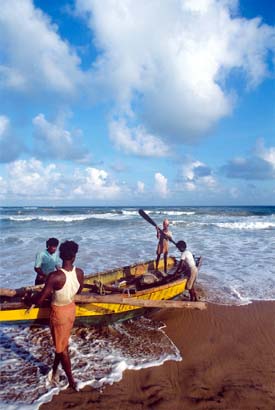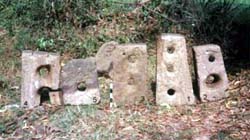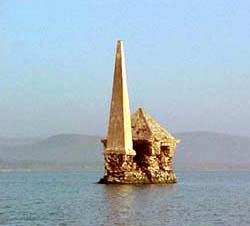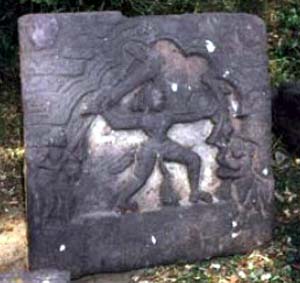Dec 13, 2025
Dec 13, 2025
The famous poet Kalidas called the king of Kalinga as 'Madhodhipati' or the Lord of the Ocean. Was it a reality or just an imagination of the poet! Marine archeologists Sila Tripathi and Surya Patnaik of National Institute of Oceanography, Goa have recently found interesting evidences from the area around Chilika Lake in Orissa, which indirectly support the description of Kalidas. Chilika lake in Orissa is the largest brackish water coastal lake in India. It has an area of 1165 sq km during monsoon and 906 sq km during winters says the Wikipedia. Chilika Lake is a wetland of international importance as it is a centre for migratory birds and many other species of life. The attraction for migratory birds and other wildlife is such that hordes of tourists flock the lake everyday. The peninsular River Mahanadi carried a heavy load and dumped part of it at its delta. As the sediment laden river met the sea in the Bay of Bengal sand bars were formed near the mouth of the river. These created a backflow of the sea water in to the sluggish river at the delta resulting in to the huge brackish water lake. This must have been formed in the later part of the Pleistocene, around 20,000 years ago when the warming phase had begun! Manikapatna is one locality near Chilika which has yielded pottery of both indigenous and foreign origin. Presence of coins, pottery and art shows that there was a regular trade between Orissa and the Mediterranean world. Sit on the Orissa coast and watch the Sun set against a backdrop of waves lapping at your feet. It's all quiet except the roar of the waves. For miles together as far as you can see it's a sea only. It's an experience. Imagine what an experience it must have been for the ancient sailors who used these coasts and ports to take off and also to land, that is why the poets of the past have sung glories about the seafaring mariners of Orissa.
Sit on the Orissa coast and watch the Sun set against a backdrop of waves lapping at your feet. It's all quiet except the roar of the waves. For miles together as far as you can see it's a sea only. It's an experience. Imagine what an experience it must have been for the ancient sailors who used these coasts and ports to take off and also to land, that is why the poets of the past have sung glories about the seafaring mariners of Orissa.
 Presence of archeological remains like stone anchors and hero stones from Manikapatna, Palur and adjoining onshore regions of Chilika lake suggest that the present brackish water lagoon was in fact a part of the Bay of Bengal. It is an interesting story, because it makes one ponder that today's near shore regions of the seas could be tomorrow's coastal lands!
Presence of archeological remains like stone anchors and hero stones from Manikapatna, Palur and adjoining onshore regions of Chilika lake suggest that the present brackish water lagoon was in fact a part of the Bay of Bengal. It is an interesting story, because it makes one ponder that today's near shore regions of the seas could be tomorrow's coastal lands!
Chilika Lake is 64 km long in the north-south direction and 13.5 km wide in the east-west direction record Sila and Surya in their research work published in the February 2008 issue of the Current Science. The shallow lagoon which is now the remainder of the lake is sandwiched between the sea and the mountains of the Western Ghats. Near Satpada the sea is connected with the lake through shallow and a narrow channel. The connecting channel is obstructed by shoals, sand spits and sand bars, thus restricting the outflow of water and also checking the tidal flow into the lake. Since outflow from the lake is restricted the lake is becoming shallower with passage of time due to deposition of sediments brought by the river. During the rainy season there is submergence and in the dry season again the land emerges.
Orissa has a rich cultural heritage. The glory of the sea coast of Orissa is well recorded in Puranas, Epics, the Vedas, early secular literature, the medieval literature, and Colonial and post Colonial literature. It appears that there was a thriving trade from the coast of Orissa with China, Southeast Asia and the Roman world.
 Since when the lake has been used for maritime activities is yet to be precisely established. Find of a shark tooth from Golbai described by B.K. Sinha in 'Archeology of Orissa' makes Sila and her colleague believe that people had started venturing in to the lake probably since the Neolithic and Chalcolithic period (2100 B.C. ' 1100 B.C.) if not earlier. Greek geographer Ptolmey (AD 150) described Palur as an important port of Kalinga and referred it as 'Paloura'. This port was situated close to the 'point of departure' located outside the southern tip of the lake at Kantiagarh, from where ships used to sail directly for Southeast Asia.
Since when the lake has been used for maritime activities is yet to be precisely established. Find of a shark tooth from Golbai described by B.K. Sinha in 'Archeology of Orissa' makes Sila and her colleague believe that people had started venturing in to the lake probably since the Neolithic and Chalcolithic period (2100 B.C. ' 1100 B.C.) if not earlier. Greek geographer Ptolmey (AD 150) described Palur as an important port of Kalinga and referred it as 'Paloura'. This port was situated close to the 'point of departure' located outside the southern tip of the lake at Kantiagarh, from where ships used to sail directly for Southeast Asia.
Chinese pilgrim Hieun Tsang (7th century AD) recorded Che-li-ta-lo-Ching as a flourishing port state Sila and her colleague. This port was located at Chhatargarh on the banks of Chilika Lake. Brahmanda Purana (10th century AD) says that Chilika Lake was an important centre of trade and commerce with ships sailing to Java, Malaya and Ceylon. It is natural that the lake was deep with a mouth wide enough to permit smooth sailing.
Lighthouses have been important markers for the seafarers since times immemorial. In the earlier days monolithic stone pillars with a lamp atop were used as light houses. Near Podaghar on a hilltop one such two metre high monolith has been found. Similar pillar has been recorded by Sila on the hill of Palur. These hills were called as 'deepa-adia pahad' (Hill of Light) on the shores of Chilika by the locals.
 What has fascinated Sila Tripathi and her colleagues is the unique find of stone anchors and hero stones from Kanas, an ancient river port situated close to Chilika Lake in Puri district and about half a kilometer from the River Nuna which drains in to the lake. These stone anchors are made of red sandstone which is prone to weathering. The hero stones it is assumed were made in the memory of heroes who lost their lives in naval battles. Since their radiometric dates are not yet available, based on historical records it is estimated that the hero stones denote battles naval battles fought between the 7th and 9th century AD. The sizes of the anchors indicate that they were used only as anchors for the boats navigating through the Chilika Lake. These anchors have one to three holes. Bamboo poles were stuck in these holes as the heavy stone lay flat in the lake bed. More than one boat thus could be tied to these poles, say Sila.
What has fascinated Sila Tripathi and her colleagues is the unique find of stone anchors and hero stones from Kanas, an ancient river port situated close to Chilika Lake in Puri district and about half a kilometer from the River Nuna which drains in to the lake. These stone anchors are made of red sandstone which is prone to weathering. The hero stones it is assumed were made in the memory of heroes who lost their lives in naval battles. Since their radiometric dates are not yet available, based on historical records it is estimated that the hero stones denote battles naval battles fought between the 7th and 9th century AD. The sizes of the anchors indicate that they were used only as anchors for the boats navigating through the Chilika Lake. These anchors have one to three holes. Bamboo poles were stuck in these holes as the heavy stone lay flat in the lake bed. More than one boat thus could be tied to these poles, say Sila.
Orissa has a rich maritime history. It was known as Kalinga in ancient times. Indian culture could spread far and wide from Orissa. The ports of Orissa were places thronged by business men from inland areas of India, like sellers of handicrafts from Varanasi and traders from far off countries. The maritime activities of the Orissa coast were affected by the frequent attacks by the neighboring kingdoms. As a consequence the financial condition of the state was affected. And above all, the nature also played truant. Tectonic activities, sea level changes and sedimentation led to the decline of ports.
Marine archeological studies at Orissa coast clearly show that Chilika Lake once acted as a useful shelter for convenient handling of cargo for the ships bound to Southeast Asian countries and other parts of the world. The lake has as a useful centre for maritime activities since 3rd millennium BC. Alas the nature never maintains a consistency. The inlet of the lake has been shifting and changing size, depth and shape since historical times. The area of the lake on an average has been shrinking at a rate of more than 4 kilometer square per year. The rate of sedimentation has been on the increase in the recent years.
Moreover Orissa coast is notorious for its share of cyclones. Past records show that between 1891 and 1970 there were 1036 cyclonic depressions in the Bay of Bengal. Out of these 360 intensified to moderate to severe storms, records Sila in yet another of her papers published in 2005 in Current Science. Cyclones can drastically change the geomorphology of the coastal sands.
Today what remains of the grand old Chilika Lake is brackish water to shallow marshy lake. The ports buzzing with maritime activities are now part of the land. It is on record all along the coasts of India the old ports which thrived once upon a time vanished and new ones developed with passage of time. What lies in future for today's ports is anybodies guess. It is time to learn to respect the nature, else newly emerged trade centres, ports and townships with swarms of people along the coasts may face the ire of the nature and become part of the history like the King of ancient Kalinga, the lord of the ocean.
20-Apr-2008
More by : V. K. Joshi (Bijji)

|
It was nice to read about Chilika lake that happens to be in my native state. This summer I had a boat ride in this beautiful lake. Water bodies and coatal regions need to be jealously protected. However, the present govts are falling prey to greed and trying sell off at costs which may be 1000th time less than what it would be after a decade or two. For instance, black-listed Sterlite Co. of Anil Agarwal, the london-based businessman, owner of Vedant is trying to acquire 10, 000 acres of land between Puri and Konark all along the coast to set up a university, a pretext to buy precious land for his business and not education. In the process the coast will be lost for ever, and along with it thousands acres of fertile land. I wrote an article 'Orissa Coast on threat' in Boloji.com. Please have a look. |